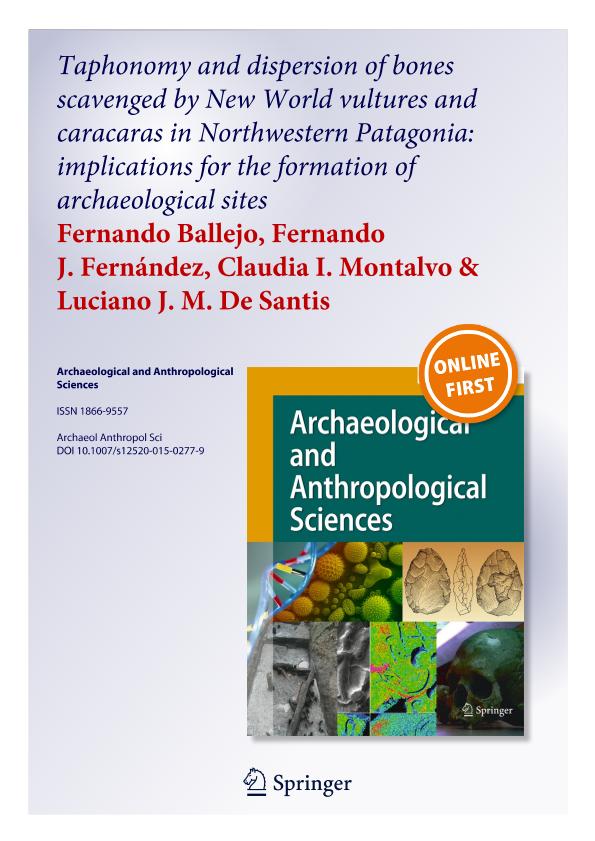Mostrar el registro sencillo del ítem
dc.contributor.author
Ballejo, Fernando

dc.contributor.author
Fernández, Fernando Julián

dc.contributor.author
Montalvo, Claudia Inés

dc.contributor.author
De Santis, Luciano J. M.
dc.date.available
2018-08-01T18:21:12Z
dc.date.issued
2016-06
dc.identifier.citation
Ballejo, Fernando; Fernández, Fernando Julián; Montalvo, Claudia Inés; De Santis, Luciano J. M.; Taphonomy and dispersion of bones scavenged by New World vultures and caracaras in Northwestern Patagonia: implications for the formation of archaeological sites; Springer; Archaeological and Anthropological Sciences; 8; 2; 6-2016; 305-315
dc.identifier.issn
1866-9557
dc.identifier.uri
http://hdl.handle.net/11336/53785
dc.description.abstract
Scavenger birds can feed on large- to small-sized vertebrates and may contribute in the formation of archaeological sites. To evaluate the modifications and dispersal patterns of bones produced by New World vulture and caracara from Northwestern Patagonia, samples of adult sheep, young sheep, and hare carcasses were offered and subsequently analyzed. New World vultures and caracaras quickly fed on the samples. Taphonomic and bone dispersal patterns suggest two types of accumulations: (1) open-air sites with large and medium-sized vertebrates represented by complete, fractured, scratched, notched, and punctured elements and (2) rock shelter or cave sites dominated by small vertebrates represented by broken, corroded, fractured, and digested elements.
dc.format
application/pdf
dc.language.iso
eng
dc.publisher
Springer

dc.rights
info:eu-repo/semantics/openAccess
dc.rights.uri
https://creativecommons.org/licenses/by-nc-sa/2.5/ar/
dc.subject
Bone Dispersal
dc.subject
Carcass
dc.subject
Northwestern Patagonia
dc.subject
Scavenger Birds
dc.subject
Taphonomy
dc.subject.classification
Historia

dc.subject.classification
Historia y Arqueología

dc.subject.classification
HUMANIDADES

dc.title
Taphonomy and dispersion of bones scavenged by New World vultures and caracaras in Northwestern Patagonia: implications for the formation of archaeological sites
dc.type
info:eu-repo/semantics/article
dc.type
info:ar-repo/semantics/artículo
dc.type
info:eu-repo/semantics/publishedVersion
dc.date.updated
2018-08-01T14:19:30Z
dc.identifier.eissn
1866-9565
dc.journal.volume
8
dc.journal.number
2
dc.journal.pagination
305-315
dc.journal.pais
Alemania

dc.description.fil
Fil: Ballejo, Fernando. Universidad Nacional de La Plata. Facultad de Ciencias Naturales y Museo; Argentina. Consejo Nacional de Investigaciones Científicas y Técnicas; Argentina
dc.description.fil
Fil: Fernández, Fernando Julián. Universidad Nacional de La Plata. Facultad de Ciencias Naturales y Museo; Argentina. Consejo Nacional de Investigaciones Científicas y Técnicas; Argentina
dc.description.fil
Fil: Montalvo, Claudia Inés. Universidad Nacional de La Pampa. Facultad de Ciencias Exactas y Naturales; Argentina
dc.description.fil
Fil: De Santis, Luciano J. M.. Universidad Nacional de La Plata. Facultad de Ciencias Naturales y Museo; Argentina
dc.journal.title
Archaeological and Anthropological Sciences
dc.relation.alternativeid
info:eu-repo/semantics/altIdentifier/doi/http://dx.doi.org/10.1007/s12520-015-0277-9
dc.relation.alternativeid
info:eu-repo/semantics/altIdentifier/url/https://link.springer.com/article/10.1007%2Fs12520-015-0277-9
Archivos asociados
